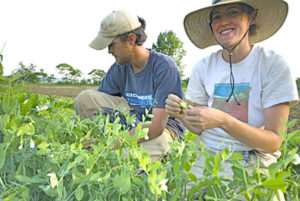 |
| Gabrielle Gosselin and Nate Drummond working in the peas. Photo by Bridget Besaw. |
By Polly Shyka
When Gabrielle Gosselin and Nate Drummond left their jobs and friends in New York City in 2006 to apprentice at Sandy and Paul Arnold’s Pleasant Valley Farm in Argyle, New Your, they were, like most farm apprentices, on an information- and skill-gathering mission. During that growing season, their ambitions began to come into focus. By paying close attention to details of the Arnolds’ diverse and profitable market vegetable operation, the couple saw the many challenges and rewards of the lifestyle and profession of farming. (See the feature story about Pleasant Valley in this MOF&G.)
Gosselin and Drummond immersed themselves in both the flavor and the best practices of the Arnolds’ operation. “The Arnolds were really open about all aspects of their farm, and the more we expressed interest, the more they were happy to talk about [their farm, including] things that might normally be uncomfortable or ‘off limits,’ like financials and bookkeeping. Nothing was off limits to us,” says Gosselin. They set their sites on finding their own farm in 2007, equipped with marketing savvy, efficiency, financial tools and goals that their mentors had imparted and the couple had synthesized.
Gosselin and Drummond were much quicker to fledge than even they expected. Through Maine FarmLink, they landed a lease in Bowdoinham, at George Christopher’s “Incubator Farm” (see The MOF&G, Fall 2008). The nearly stoneless, flat and fertile soils on the shores of Merrymeeting Bay have most likely been farmed since the area was first settled in 1720.
 |
| Looking south over the fields farmed by Six River Farm and Fishbowl Farm, with Merrymeeting Bay beyond. Photo courtesy of Gabrielle Gosselin and Nate Drummond. |
In their first season as farm entrepreneurs at their Six River Farm, the couple cultivated 2 acres by themselves. The set-up and myriad decisions of a first season kept them from hiring any help. Both admit they could have used it, but they did not want to add labor management to their already overflowing plate.
Marketing Savvy
“All Brunswick, All the Time” is the couple’s marketing mantra. Though initially wary of having all their eggs in one basket, they are pleased with their decision to attend all three Brunswick farmers’ markets weekly, and not to drive farther than Freeport, where they deliver to a few restaurants. Eighty percent of their income comes from the farmers’ market and 20 percent from wholesale accounts, such as Morning Glory and Royal River Natural Foods and a handful of restaurants.
They could easily have extended their marketing to Portland, but their clear vision has paid off. “We have relationships with many of our customers that approximate what CSA farmers have with their shareholders,” says Drummond. “The form of payment is different, [but] most of our business at the farmers’ markets are regular customers. We see some of them three times per week.”
The couple markets its business by sending a farmer to market. While many farms have apprentices or employees cover their market stands, Gosselin and Drummond reap the benefits of putting in the sales time themselves. “An important part of our marketing is that our customers get to have ‘face time’ with us. We engage with them; learn their names and stories and take the time to talk about things beyond the lettuce they are buying. They can expect us there.”
 |
| Looking east across Abbagadassett Point, with fields and greenhouses of Six River Farm and Fishbowl Farm in the foreground, and fields farmed by Atlantic Organics, Small Wonder Organics and Fairwinds Farm beyond. Photo courtesy of Gabrielle Gosselin and Nate Drummond. |
Another aspect of their marketing savvy is their always abundant and consistent display. By planting successive crops throughout the growing season, their product array is arrestingly beautiful, and cooks can always find what they’re looking for when it’s in season. Favorite crops include ‘Space’ spinach, ‘Carmona’ and ‘Adrianna’ Boston lettuce, ‘Golden’ beets, ‘Hakurei’ salad turnips and ‘Carmen’ peppers – the best variety of pepper, they say; “sweet, early and productive.”
Season Extension
To push the season for earlier production, Gosselin and Drummond have invested in three types of low-tech, moveable structures. The simplest is a “caterpillar” – bent metal or plastic pipes spanning one or several 4-foot beds and covered with Remay and/or plastic. Six River grows early greens in some caterpillars in the spring and peppers and eggplants under others in midseason. Simple ground-level eyehooks hold rope that zigzags down the “back” of the caterpillar, holding the plastic in place. Venting involves pushing up and clipping the plastic to a pipe at intervals down the row. Growers and businesses such as Johnny’s Selected Seeds are trying variations on this structure. (See photos and resources at www.johnnyseeds.com.)
Their second type of structure is a 20- x 96-foot “deliberately underbuilt” Gothic arch hoophouse. Normally such a hoophouse would have baseboards, roll-up sides and hip boards at shoulder height, but for greater mobility, Gosselin and Drummond secured the plastic to the frame with the same zigzagged rope technique used with caterpillars. The house is anchored with traditional ground posts, with bent metal pipes fastened to them. Diagonal bracing between pipes secures the house from winter winds. This house is moved to new ground annually and in one year will cover spring greens, solanaceous crops and fall greens.
 |
| Nate Drummond tills beds next to spring pea plantings. Photo by Bridget Besaw. |
With Rimol Greenhouse’s Rolling Thunder hoophouse, Gosselin and Drummond attain remarkable results. Spinach, kale, rainbow chard and lettuce are transplanted into the ground in fall, and on November 1, the Rolling Thunder is moved over them, and, in addition to the Rolling Thunder cover, the crops get another layer of protection from hoops draped with Remay. These greens will produce all winter and “kick into major production in March,” says Gosselin. An early spring (April 1, ideally) allows the couple to seed carrots and transplant beets into a plot adjacent to the hoophouse, and then the Rolling Thunder is moved to cover them. These roots need only a month-long boost to be harvestable for spring markets.
On May 1, parthenocarpic summer squash and cucumbers are transplanted in the next plot along the line. Parthenocarpic varieties set fruit without pollination, so, once covered with Remay, the cover does not have to be removed for pollination. Cucumber varieties include: ‘Diamant,’ ‘Diva,’ ‘Saber’ and ‘Vertina,’ with ‘Saber,’ a slicing type, being the favorite. Parthenocarpic zucchini varieties include ‘Partenon,’ ‘Sulton’ and ‘Segev.’
“We start all our cucurbits in the greenhouse in 72-cell Speedling trays and plant out at approximately three weeks [from seeding],” says Drummond. One month after being moved onto the cucurbits, the house is moved again to cover tomatoes, peppers and eggplants for the summer. These heat-loving crops also seem to appreciate the extra summer warmth coming from Merrymeeting Bay. “For a Southern Maine location, our summers temperatures are quite mild,” Gosselin says. “Everything is moderated by the seabreeze.”
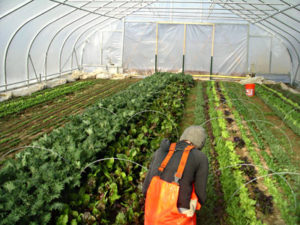 |
| Gabrielle harvesting greens in the Rolling Thunder greenhouse in early March. Photo courtesy of Gabrielle Gosselin and Nate Drummond. |
As more cities and towns host winter farmers’ markets, more consumers expect “their” farmers to grow and market crops year round. Balancing winter downtime with the desire to fulfill customer demand has challenged Drummond and Gosselin. They’re putting up another Rolling Thunder house this spring and estimate that they could quadruple winter greens production and still sell out each week. But harvesting in winter makes for cold fingers. “Having a warm wash space is one aspect of winter growing that bears consideration,” says Drummond. They can heat a small area of their packing shed but estimate that “everything takes twice as long in winter.” They do plan to expand winter greens production but note that their precious downtime is getting whittled away by year-round farming.
Efficiencies and Profitability
Mindful of the field layout, crop rotation plan, packing facilities and other aspects of Pleasant Valley Farm, Gosselin and Drummond planned Six River Farm for high efficiency and high profit from day one. Their goal was to make a living from 5 to 10 acres of mixed vegetables.
“We tried to prioritize pieces of equipment that we would need at that larger scale,” says Drummond. “We were able to scale up a little faster … because of the lease arrangement. [It] has allowed us to invest in the equipment and hoophouses early on.”
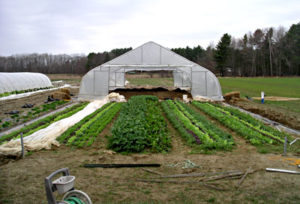 |
| The Rolling Thunder greenhouse just after it was moved off winter greens (around early April) to a spot that will soon be planted to carrots and beets. Photo courtesy of Gabrielle Gosselin and Nate Drummond. |
Had the couple needed to purchase land or a house, the picture would have been different. Investing in money-making endeavors while renting land and a house has enabled Six River Farm to grow quickly and smoothly into a profitable business.
“We set up our farm with a standardized bed system,” says Drummond. “We invested in several tractors for redundancy in case of breakdowns and so that we would not be needing to switch out cultivators and implements as often.” They use two John Deere tractors for such jobs as plowing, discing, rototilling and bucket loading, and two smaller cultivating tractors to prepare stale seedbeds, mark rows and cultivate with belly mounted baskets, sweeps and knives.
Six River Farm benefits by sharing the Christopher land with other farmers, who also share equipment that is easily moved and used sporadically, such as a three-bed boom sprayer, subsoiler plow and barrel washer. Drummond says, “We can invest in things we know we need, [our neighboring farmers] don’t have, and that way we can share them with other people.”
Six River Farm grossed an impressive $30,000 per acre in 2010. While Gosselin and Drummond do not calculate how many heads of lettuce they sold through the season, they do pay attention to quantities they have for market. “We are not going to stop growing a crop if it is not profitable,” says Gosselin. “As long as we are profitable on a per acre basis, we are happy to grow the full range of vegetables for our customers.”
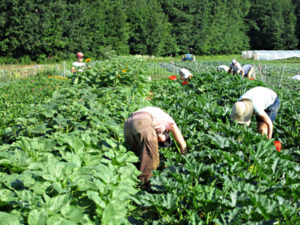 |
| The Six River Farm crew harvesting summer squash and sunflowers in July. Photo courtesy of Gabrielle Gosselin and Nate Drummond. |
Labor
One marked difference between the Arnolds’ Pleasant Valley Farm and Six River Farm is the workforce. The Arnolds hire some hourly laborers and have had apprentices for 15 years. Gosselin and Drummond have only hourly employees, and they like it that way. They themselves rent a nearby house nearby and did not want to house apprentices on the farm when they were not living there. They have also found and retained great employees.
“Everyone always says ‘never hire your friends,’ but it has worked out so well for us,” says Gosselin. “It turns out that, one, our friends have really good work ethics; and two, most have worked on other farms.” With 15 employees from April through November 2010, some full and some part time, Drummond extols the virtues of a payroll service. “All we have to do is send off an email every two weeks with everyone’s hours. That’s it. It costs about $30 [every two weeks].
“We pay hourly. Our hours are really clearly 7 a.m. to 4 p.m., with one-half hour lunch break. We are small enough that we can organize our workday so that we work with our employees most of the time. The experience is not unlike an apprenticeship.” Gosselin and Drummond clearly enjoy each other and working with others. “We really benefited from being apprentices, but from a management perspective, we think having hourly employees is a bit easier,” says Drummond.
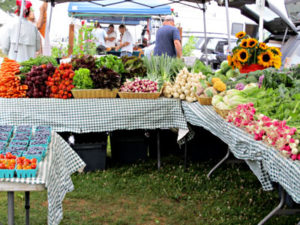 |
| Six River Farm’s stand at the Crystal Spring Farmers’ Market in Brunswick in mid-July. Photo courtesy of Gabrielle Gosselin and Nate Drummond. |
When the work load is extra heavy, employees are offered extra hours, but the couple would rather find an extra employee than overwork existing help. “[Our employees] like the quality of life of working on a farm. We don’t want them to burn out,” says Gosselin.
Quality employee management at Six River Farm has kept productivity high while keeping labor expenses low, at 20 percent of gross profit.
The Six River Farm crew harvests on Mondays and Thursdays for markets on Tuesdays, Fridays and Saturdays. For those left on the farm, Tuesdays are cultivation days, or “tractor Tuesday,” as the crew affectionately calls them.
“Weather willing, cultivation is a designated part of the work week,” says Drummond. “It is easy to stay on top of [the weeds] if we wet aside a time each week. This has a huge effect on personal and employee morale. We have noticed that employees like to get things done. Harvesting or weeding, it doesn’t really matter, but that a job is accomplished.” Having weeds under control with the help of tractor-mounted cultivators adds to the farm’s efficiency and employee satisfaction, limits future weed populations, and enhances the farm’s bottom line.
Looking Ahead
In 2010, Six River Farm rented an established 1/2-acre highbush blueberry parcel. The late winter pruning needs complemented their vegetable operation, and their customers and employees love blueberries.
“It was so fun to have fruit at market,” says Gosselin. “[Picking] is a job we all get to do standing up” – sweet relief to the farmers and workers. The couple hired extra help in the busy July flush. Both are excited to expand into more fruit production in the future.
Adding more perennial crops such as rhubarb, raspberries and asparagus to their market offerings depends in part on securing a longer lease or purchasing a house and land nearby.
Regarding expanding beyond the 8 acres they cultivated in 2010, they say, “We sell everything at places where we get a very good price for it. So the idea of getting bigger to sell for cheaper is not appealing. But we are also big enough so that we can use some of the efficiencies of equipment and scale to make it profitable. It feels like a good place to be.”
About the author: Polly Shyka is a farmer living in Freedom, Maine. She and her partner, Prentice Grassi, live and farm at Village Farm with their three young sons.
